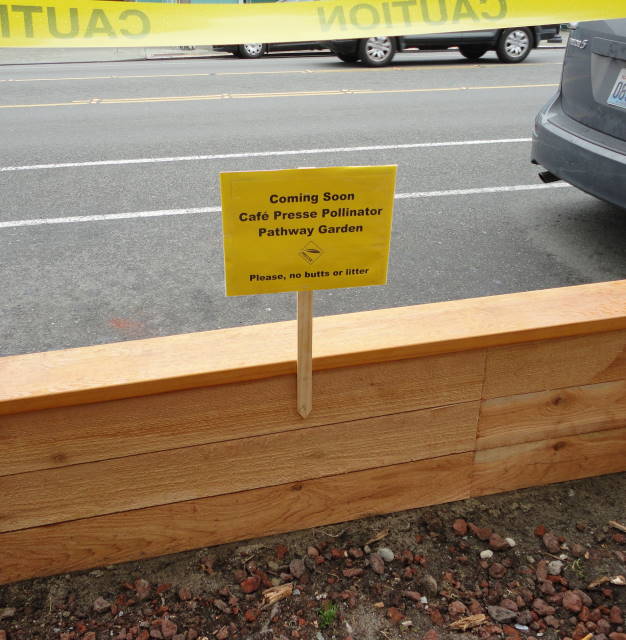
You may have noticed the wooden box that has recently appeared on the sidewalk in front of Cafe Presse. If so, you may have asked yourself “what is that thing?”.
The short answer is: Its a planter box.
The longer answer is that it is the beginnings of our plan to support the Pollinator Pathway project in their effort provide food and habitat for the native pollinators that are crucial to every garden in the area.
To start from the beginning, there are two tree pits in front of Cafe Presse. A tree pit is basically dirt and gravel filled holes left in the sidewalk so that trees can be planted. Unfortunately, the tree in one of our tree pits died some time in the past and ever since Cafe Presse has been open, all that has remained of this tree is its sad stump. The tree in the south-most pit is alive and well, but the shallow, gravely pits tend to attract garbage and cigarette butts, and they also pool water during rainy stretches so that they spend a large part of the year as muddy pools of standing water.

After walking past these eye-sores everyday for 4 years on the way to work, the ideas was hatched that we should try to reclaim them by planting our own gardens. When I heard about the Pollinator Pathway, and how it will pass so close to Cafe Presse, it seemed like a natural to include our tiny gardens in the effort.
So what is the Pollinator Pathway?
The basic idea is this: native pollinators, like bees, butterflies, hummingbird and bats, do the essential work of pollinating plants. However, these pollinators can often find the urban setting of a city a difficult place to find habitat. The Pollinator Pathway project aims to make their lives a bit easier by creating a corridor of gardens full of plants that provide food and shelter to native pollinators. This from their website:
The planned site of the Pollinator Pathway is on Columbia Street between 12th and 29th avenues. The location is bookended by two existing green spaces–Seattle University and a small park called Nora’s Woods. Seattle University has a long history with sustainable landscaping methods, and houses a pollinator friendly garden. Nora’s Woods is a tiny woods that hosts many native, pollinator friendly plants.
OK I know, Cafe Presse is not along Columbia street. However, we are very near it, and we are right next to Seattle University. Our plan is to plant the two tree pits with low water, pollinator friendly, native plants, following the recommendations from the Pollinator Pathway project. Hopefully, the result will be economical, good for the environment and will beautify the neighborhood a bit.
The first step with any project that involves public sidewalks is to get the approval of the city. However, I was pleasantly surprised at the lack of red tape involved with getting approval for our garden. I called the City of Seattle Department of Transportation, who sent a representative around to look at the pits before giving their judgement. After a few questions about what we wanted to do, we got a quick answer. “By all means, please beautify these pits as much as you like”.
Their only proviso was that we be careful of the live tree that is currently growing in the south pit. This means that we cannot heap up soil around the trunk of the tree, as this will smother it, and we also need to be careful as we dig around the its roots.
With this in mind, we decided to build a box around the empty north tree pit so that we can bring in a significant amount of soil. You will notice that this box has a bench seat that will make it a comfortable place to enjoy the garden (or a cigarette away from the entrance to Cafe Presse…please no butts in the garden!). In this box, we plan larger plants and bushes. In the south pit, we will add a layer of topsoil and use smaller plants that can be accommodated among the tree roots.
So that’s the project. I am not sure exactly how long it will take to finish…lets just call it an “ongoing project” to avoid unrealistic expectations. I will post more photos as we progress.
By the way, the garden box was designed and build by local artisan Jake Sausman. It is made made of cedar, which is naturally resistant to the deleterious effects of contact with wet soil and therefore useful in the garden. Also naturally good looking.


It’s a great idea. And, although your restaurant is not on Columbia, Seattle U uses pollination friendly plants throughout their campus, and perhaps someday they will even plant a few of them on the east side of Xavier Hall stretching the pollinator pathway right to your two boxes.